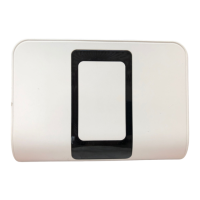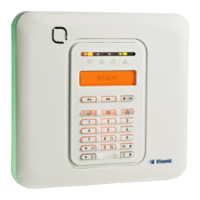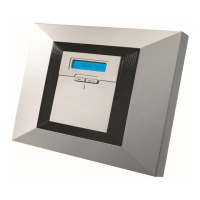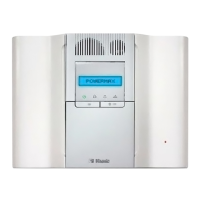4. PROGRAMMING
20 D-305735 PowerMaster 360 Installer's Guide
- Configuring New Devices
"NEXT Device" to enroll the next device.
"MODIFY Same Dev." reverts to Step 1 (i.e. "LOCATION") to allow you to perform additional changes to the
device, if needed.
"EXIT Enrollment" exits the enrollment procedure and returns to Step 1 bringing you back to the "ADD NEW
∗ Can be customized by “06:CUSTOM NAMES” menu (see section 4.7)
Zone Type List
1. Exit/Entry 1 This Zone starts the exit time when the user arms the system or the entry time when the
system is armed. To configure the Exit/Entry 1 time, see sections 4.5.1 & 4.5.2 - Installer
Mode menu "03.CONTROL PANEL" options 01 and 03. (∗)
Same as Exit / Entry 1 but with a different delay time. Used sometimes for entrances closer to
the panel. For configuring the Exit and Entry 2 delays, see sections 4.5.1 & 4.5.2 –
Installer Mode menu "03.CONTROL PANEL" options 02 and 03. (∗)
Used for Door/Window Contacts and Motion sensors protecting entrance doors to interior
living areas where you wish to move feely when the system is armed HOME. Functions as a
"Delayed" zone when the system is armed HOME and as a "Perimeter Follower" zone when
the system is armed AWAY.
Similar to "Interior" zone but temporarily ignored by the alarm system during entry/exit delay
periods. Usually used for sensors protecting the route between the entrance door and the panel.
5. Interior
This zone type generates an alarm only when the system is armed AWAY but not when the
system is armed HOME. Used for sensors, installed in interior areas of the premises, that
need to be protected when people are not present inside the premises.
This zone type generates an alarm when the system is armed both in AWAY and HOME
modes. Used for all sensors protecting the perimeter of the premises.
Similar to "Perimeter" zone, but is temporarily ignored by the alarm system during entry/exit
delay periods. Usually used for sensors protecting the route between the entrance door and
This zone type is active 24 hours, even when system is DISARMED. It is used to report alarm
events from sensors or manually activated buttons to the Monitoring Station or private
telephones (as programmed) without activating the sirens.
Similar to 24hr silent zone, but also provides an audible siren alarm.
Note: This zone type is used only for burglary applications.
This zone type is active 24 hours, even when the system is DISARMED. It is used to report
an emergency event and to initiate an Emergency call to the Monitoring Stations or private
telephones (as programmed).
An Arming key zone is used to control the arming and disarming of the system.
Note: Operates with the magnetic contact device, magnetic contact device with auxiliary input
and vanishing magnetic contact device.
This zone does not create an alarm and is often used for non-alarm applications. For
example, a detector used only for sounding a chime.
A Fire zone is used for connecting the MC-302E (magnetic contact with hard-wired input) to a
wired smoke detector.
A Guard keybox zone is usually connected to a metal safe containing the physical keys
needed to enter the building. Following an alarm, the safe becomes available to a trusted
Guard who can open the Guard keybox, obtain the keys and enter the secured premises. The

